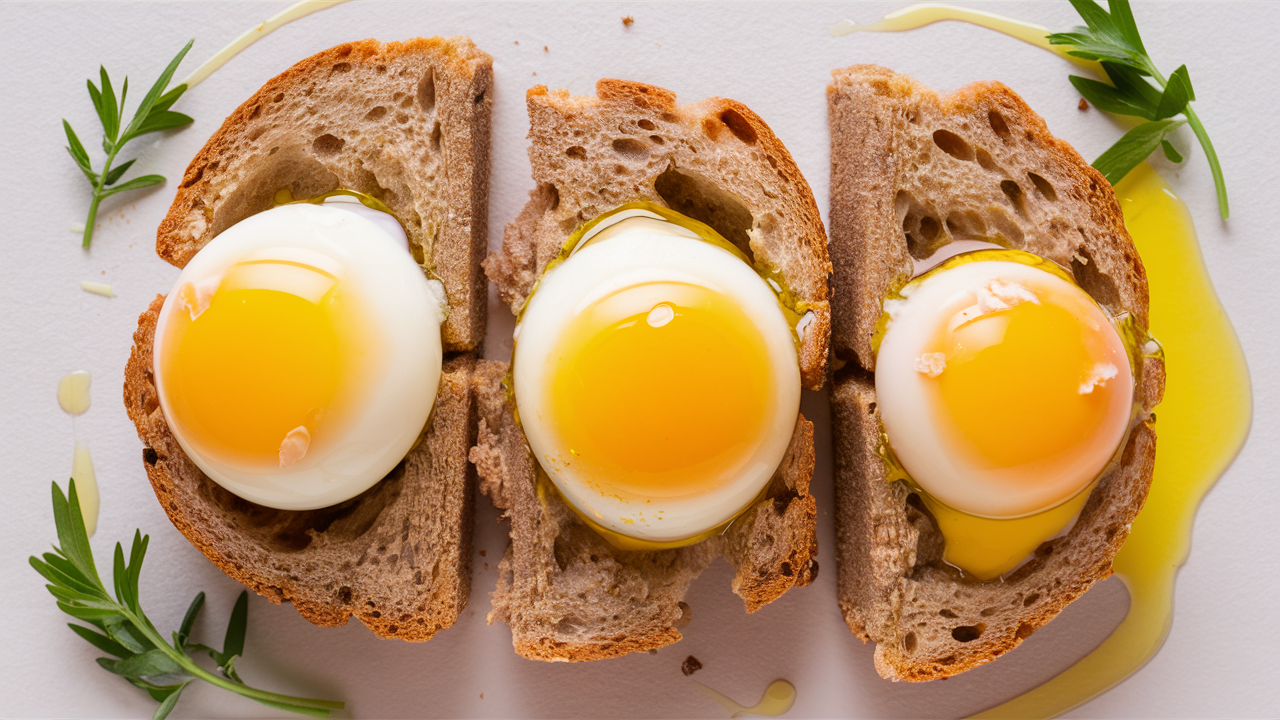How to Replace Eggs in Gluten-Free Bread
Replacing eggs in gluten-free bread can be challenging, but it’s entirely possible with the right knowledge and ingredients. Whether due to allergies, vegan preferences, or simply running out of eggs, finding suitable alternatives is essential to achieving the perfect gluten-free loaf. In this guide, we’ll explore the best ways to substitute eggs in your gluten-free bread recipes, ensuring that your bread remains delicious, moist, and well-structured.
Why Replace Eggs in Gluten-Free Bread?
There are several reasons why you might need to replace eggs in your gluten-free bread recipes:
- Allergies: Egg allergies are common, particularly in children, and can range from mild to severe. For those with egg allergies, even a small amount of egg can trigger a reaction.
- Vegan Diet: Vegans avoid all animal products, including eggs. Therefore, finding suitable substitutes is essential for those following a vegan lifestyle.
- Dietary Preferences: Some people choose to reduce their egg consumption for health reasons, such as lowering cholesterol intake, or due to personal or ethical beliefs.
- Availability: Sometimes, you might simply run out of eggs and need to find an alternative without a trip to the store.
Understanding the Role of Eggs in Bread Baking
To effectively replace eggs in gluten-free bread, it’s important to understand their role. Eggs serve multiple functions in baking:
- Binding: Eggs help hold ingredients together, providing structure and stability to the bread.
- Moisture: Eggs contribute to the moisture content, ensuring the bread doesn’t turn out dry or crumbly.
- Leavening: Eggs help the bread rise by trapping air bubbles within the dough, contributing to a lighter texture.
- Flavor and Color: Eggs add richness to the flavor and can give the bread a golden color when baked.
Given these roles, it’s clear that replacing eggs requires careful consideration to ensure your gluten-free bread still turns out well.
The Best Egg Substitutes for Gluten-Free Bread
When it comes to substituting eggs in gluten-free bread, not all replacements are created equal. The key is to choose an alternative that replicates the binding, moisture, and leavening properties of eggs. Here are some of the most effective substitutes:
1. Flaxseed Meal
Flaxseed meal is one of the most popular egg substitutes in vegan and gluten-free baking. When mixed with water, flaxseed meal forms a gel-like consistency that mimics the binding properties of eggs.
- How to Use: Mix 1 tablespoon of flaxseed meal with 3 tablespoons of water and let it sit for 5-10 minutes until it thickens. This mixture can replace one egg.
- Best For: Binding and moisture. Flaxseed meal is ideal for dense, hearty breads, as it adds a slight nutty flavor and additional fiber.
2. Chia Seeds
Similar to flaxseed, chia seeds also form a gel when mixed with water, making them an excellent egg replacement.
- How to Use: Mix 1 tablespoon of chia seeds with 3 tablespoons of water and let it sit for 10-15 minutes. This mixture can replace one egg.
- Best For: Binding and moisture. Chia seeds are great for adding structure to gluten-free bread while contributing to a healthy dose of omega-3 fatty acids.
3. Applesauce
Unsweetened applesauce is a common egg substitute in both gluten-free and traditional baking. It adds moisture and can contribute to a tender crumb.
- How to Use: Replace each egg with 1/4 cup of unsweetened applesauce. If using sweetened applesauce, you may want to reduce the sugar in your recipe.
- Best For: Moisture and a slight sweetness. Applesauce works well in sweeter bread recipes, such as gluten-free banana bread or cinnamon rolls.
4. Mashed Banana
Mashed banana is another popular egg substitute, particularly in sweet breads. It adds moisture and a subtle banana flavor.
- How to Use: Replace each egg with 1/4 cup of mashed banana.
- Best For: Moisture and flavor. Banana works best in recipes where the banana flavor will complement the other ingredients, such as in quick breads or muffins.
5. Aquafaba
Aquafaba is the liquid found in a can of chickpeas. It has gained popularity as an egg substitute because it can be whipped into a foam, similar to egg whites.
- How to Use: Use 3 tablespoons of aquafaba to replace one egg. If whipping, beat it until soft peaks form.
- Best For: Leavening and moisture. Aquafaba is ideal for lighter, fluffier bread recipes, such as gluten-free sandwich bread or rolls.
6. Baking Powder and Vinegar
A combination of baking powder and vinegar can mimic the leavening properties of eggs. The reaction between the acid (vinegar) and the baking powder produces carbon dioxide, which helps the bread rise.
- How to Use: Mix 1 tablespoon of baking powder with 1 tablespoon of vinegar (apple cider vinegar or white vinegar) to replace one egg.
- Best For: Leavening. This substitute is best for recipes where a light, airy texture is desired.
7. Yogurt or Buttermilk
Dairy-free yogurt or buttermilk (or their dairy equivalents) can replace eggs by adding moisture and a bit of binding power to your gluten-free bread.
- How to Use: Replace each egg with 1/4 cup of yogurt or buttermilk.
- Best For: Moisture and a slight tang. These substitutes work well in recipes where a tender crumb is desired, such as in gluten-free quick breads or cakes.
Tips for Replacing Eggs in Gluten-Free Bread

When replacing eggs in gluten-free bread, there are a few tips to keep in mind to ensure the best results:
- Combine Substitutes: Sometimes, using a combination of egg substitutes can yield better results than using just one. For example, you might use flaxseed meal for binding and aquafaba for leavening.
- Adjust Liquids: Depending on the substitute you choose, you may need to adjust the liquid in your recipe. For example, if using a fruit puree like applesauce or banana, you may need to slightly reduce other liquids.
- Watch the Bake Time: Egg-free gluten-free bread can take longer to bake than recipes with eggs. Be patient and use the toothpick test to check for doneness.
- Add Extra Binding Agents: Since gluten-free flours lack the elasticity of wheat flour, you might need to add extra binding agents like xanthan gum or psyllium husk when omitting eggs to prevent crumbling.
- Flavor Considerations: Some egg substitutes, like banana or applesauce, will add flavor to your bread. Make sure the substitute complements the other flavors in your recipe.
Common Challenges and Solutions
Replacing eggs in gluten-free bread can come with a few challenges. Here are some common issues and how to address them:
- Dense Bread: Without eggs, your bread may turn out denser than expected. To counteract this, use substitutes that add leavening, like aquafaba or the baking powder-vinegar combination.
- Crumbly Texture: Eggs help hold bread together. If your bread is too crumbly, consider adding extra binding agents, like flaxseed meal, chia seeds, or psyllium husk.
- Dryness: Gluten-free bread can be prone to dryness, especially without eggs. Substitutes like applesauce, yogurt, or mashed banana can help add moisture.
- Poor Rise: Without eggs, gluten-free bread may not rise as well. Ensure your substitute provides some leavening power, and consider increasing the amount of yeast or adding a bit more baking powder.
Frequently Asked Questions (FAQs)
Q: Can I replace eggs in all gluten-free bread recipes?
A: Yes, you can replace eggs in most gluten-free bread recipes. However, the results may vary depending on the type of bread and the substitute used. It may take some experimentation to find the best substitute for your specific recipe.
Q: What is the best egg substitute for gluten-free sandwich bread?
A: Aquafaba or a combination of flaxseed meal and baking powder/vinegar are often the best substitutes for gluten-free sandwich bread, as they provide both binding and leavening.
Q: How do I store gluten-free bread made without eggs?
A: Gluten-free bread without eggs should be stored in an airtight container at room temperature for up to 2 days. For longer storage, wrap the bread tightly and freeze it. Thaw it at room temperature or toast slices directly from frozen.
Q: Can I use commercial egg replacers?
A: Yes, commercial egg replacers, like Bob’s Red Mill Egg Replacer or Ener-G Egg Replacer, are formulated to mimic the properties of eggs and can work well in gluten-free bread recipes.
Q: Will my bread taste different without eggs?
A: Depending on the substitute used, your bread may have a slightly different flavor. For example, using mashed banana or applesauce will add a fruity note, while flaxseed meal will add a mild, nutty flavor.
Experimenting with Egg Replacements
One of the joys of baking is experimentation. When replacing eggs in gluten-free bread, don’t be afraid to try different substitutes and combinations to see what works best for your taste and texture preferences. You might discover a new favorite ingredient that not only replaces eggs but also enhances the overall flavor and nutrition of your bread.
Nutritional Benefits of Egg Substitutes
Many egg substitutes offer additional nutritional benefits that eggs don’t. For example:
- Flaxseed and chia seeds: These are rich in omega-3 fatty acids, fiber, and antioxidants, contributing to heart health and digestive wellness.
- Aquafaba: Being low in calories and fat, aquafaba is a great option for those looking to reduce their fat intake.
- Applesauce and banana: These fruits are packed with vitamins, minerals, and fiber, adding natural sweetness and nutrition to your bread.
By incorporating these substitutes, you’re not only making your gluten-free bread egg-free but also boosting its nutritional profile.
Conclusion
Replacing eggs in gluten-free bread might seem daunting at first, but with the right knowledge and ingredients, it’s entirely achievable. Whether you’re doing it for health reasons, dietary preferences, or simply out of necessity, there are plenty of effective substitutes that can help you bake delicious, moist, and well-structured bread.
Experiment with different substitutes to find the ones that work best for your specific recipe and taste preferences. With a bit of creativity, you can enjoy a wide variety of gluten-free, egg-free breads that are just as satisfying as their traditional counterparts.

